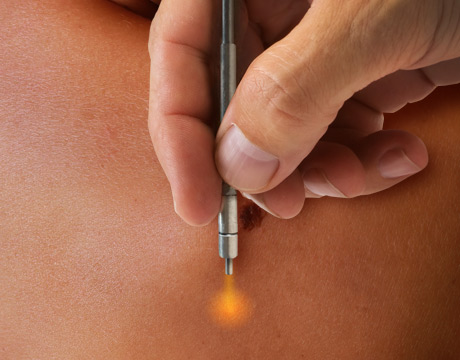A New Ally Against Skin Cancer
A New Ally Against Skin Cancer


A spectroscopy probe.
James Tunnell, associate professor of biomedical engineering at the University of Texas, grew up in Corpus Christi, taking in the beach as child. Though he enjoyed all the fun that came with it, he was aware of something else as well. “I was aware of skin cancer from that environment and I also had a family history of it,” he says. “It would be nice to hopefully be able to do something about it.”
His team is working on a device for detection that he hopes will reduce the number of costly CT scans needed and speed up detection. “There was a linking up with some faculty at MD Anderson [Cancer Center], so we built up a prototype and worked on a concept and I was then also introduced to collaborator Jason Reichenberg,” he says. “The device is kind of in two pieces. There’s a box, the instrument that houses the lights and light spruces and detectors, and it’s on a cart where you wheel it around similar to a cart in a hospital. The other piece is a handheld probe shaped like a pen and is connected via fiber optic to the cart. The technician or physician holds the pen in their hand and places it in contact with the skin, hits a button and it cycles through shining different colors of light. The goal is a ‘yes-no’ device when it comes to skin cancer.” He describes the inside of the pen as a bundle that contains different types of optical fibers. “What we did was combine three different kinds of spectroscopy,” he says. “You have to arrange the fiber in specific geometry and put lens and filters inside of there. Fibers are on the order of 200 microns in diameter and, depending on what version, we’re talking about maybe 10 of those fibers inside of the pen.”
One challenge was in the area of speed. “Patients don’t spend a lot of time in the room so you need to be quick in getting the data you want,” he says. “We built prototypes before that were way too big and slow because of practical reasons. Fortunately technology caught up in the last five or ten years and LED is becoming very cheap.” It now takes just a few seconds for a measurement, he says, and the third generation of the device is roughly a quarter of the size it once was. “It was once about the size of a desk,” he explains.
Their results for melanomas and non-melanoma have been very strong, he says. In addition, they recently started a clinical study with 250 patients. All three spectroscopies are being performed through one fiber in one handheld probe and they will see if they can maintain a high level of accuracy.
“A hope is that when we are finished with the trial work that someone with good commercial experience will find a great market for it and we can get these devices helping the public,” he says. “I think there are possibly a number of scenarios where it could improve care. People are reluctant to get tested if they think they will get cut on. And think about how many biopsies it can take to find one melanoma. This could make things different.”
Eric Butterman is an independent writer.
Learn about the latest trends in bioengineering at ASME’s Global Congress onNanoEngineering for Medicine and Biology.
Think about how many biopsies it can take to find one melanoma. This could make things different.Prof. James Tunnell, University of Texas





